#air nomads
Text


Powerful woman 🛐
#avatar yangchen#yangchen#atla#avatar the last airbender#atla art#the dawn of yangchen#the legacy of yangchen#air nomads#украрт
4K notes
·
View notes
Text
Something Something Avatar The Last Airbender was fundamentally about showing the horrible long-lasting effects of both war and violence in a grand sense (the way people suffer under fire nation occupation including the air nomad genocide and the state of the southern water tribe) but also a personal sense (zukos entire arch) and the show goes to great lengths to avoid glorifying war, often specifically choosing only depict the aftermath of terrible violence while not graphically depicting the violence itself.
And I think it's a profound misunderstanding, maybe even an insult to the source text to continually depict gratuitous death and violence as a focal point of the live action.
#i can provide example of this if need be#the depiction of the air nomads being invaded by the fighting#kataras mothers body#zuko and ozais agni kai#theres probably more#but thats what ive gathered from cultral osmosis alone#atla#atla live action#atla netflix#avatar#avatar the last airbender#live action avatar#prince zuko#atla zuko#zuko#avatar aang#aang#atla aang#air nomads#katara#katara atla
5K notes
·
View notes
Text
Aang: All life is sacred. I cannot, and will not, compromise my values. I mustn't take even just one life. Even if it's a monster's life, my philosophy – my culture's philosophy – is to avoid taking life at all costs. As much as you'll try to drill it in me, it's not who I am. I'm not going to kill the a single living creature, not even the Fire Lord.
Meanwhile, Sokka:
#yes i know aang ended up agreeing to kill the fire lord and THEN met the lion turtle#but this is a joke stfu#<3#atla#aang#sokka#avatar: the last airbender#avatar the last airbender#avatar#avatar aang#sozin's comet#suki#toph#atla memes#avatar memes#a:tla memes#a:tla#atla sokka#atla aang#air nomads#avatar the last airbender memes#avatar: the last airbender memes
3K notes
·
View notes
Text

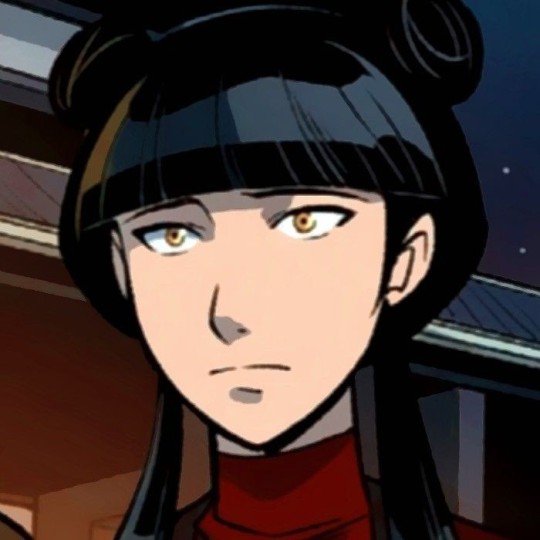

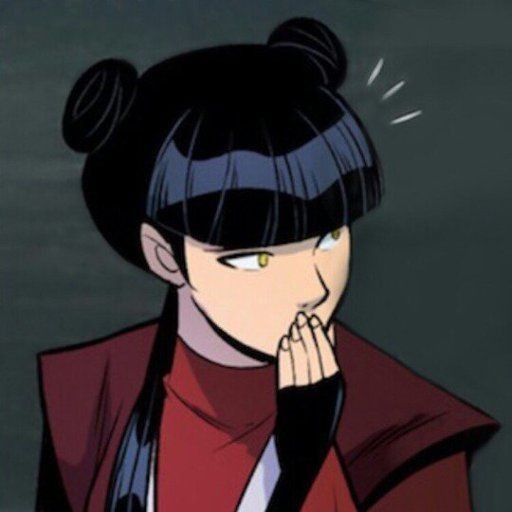
Can we appreciate comics Mai😌
#avatar the last airbender#atla#atla netflix#netflix atla#uncle iroh#zutara#kataang#maiko#aang#katara#sokka#toph#atla suki#zuko#mai atla#azula#ty lee#aesthetic#icons#air nomads#water tribe#earth kingdom#fire nation
2K notes
·
View notes
Text
Aang getting so, uncharacteristically angry when Appa was taken by the sandbenders wasn’t just because of his love for his sky bison. Of course, that was a big part of it. Appa is more than just a pet to him, he’s his best friend and soulmate, someone who’s been around since Aang was very young and is meant to be a “companion for life”.
But, Aang ran away on a random Tuesday, got caught in a storm and it changed the whole trajectory of his life. He ran away because he was upset his life was changing so rapidly, he suddenly had all this responsibility at 12 years old that he wasn’t ready for but that doesn’t mean he wouldn’t have gone back. We don’t know what would have happened; he could have needed a few days to cool off, he could have seen the start of the war and stepped up (from what we know of Aang, there’s no way he would have ignored it for his own needs), but that didn’t happen.
He got caught in the ice for 100 years and when he woke up he discovered that not only was everyone he knew and loved were dead, but brutally murdered in an act of power. That everyone from his teachers, friends (children, like him) and animals, were gone. Not only that but his whole culture; traditions, foods, clothing, music… everything important was eradicated and possibly most of the documentation of the culture, too. He’s suddenly handed this new responsibility on top of being the Avatar, trying to uphold this culture (as literally the last airbender alive) and grieve at the same time.
And Aang grieves very privately, in fact, does he even give himself a chance? He discovered the horrible truth and his immediate response it so go have some fun, maybe because he knows if he thinks too hard about it and gives into the pain, he’ll turn into something he’s not, he’ll forget what the monks taught him and he can’t let that happen.
So he tries to channel all his grief and anger into being the Avatar, even if he still has his reservations, and by his side is Appa. The only thing keeping him tethered to his life 100 years ago and his culture. He’s been with him through everything, and will continue to be, like I said “companion for life”.
And then he’s gone, he’s taken, and all of a sudden Aang cannot keep the crushing weight of his loss at bay anymore and he… snaps, he loses control. He gives into the avatar state because not only is everything he knew and loved gone, taken from him for nothing more than political gain, but now his soulmate that represented everything he lost is gone, too and he doesn’t know what happened to him. Is he dead? Is he scared? Is he fed? Who knows.
Aang losing Appa with the final straw and his grief, something he was ignoring and refusing to deal with, was brought to the forefront when he lost Appa, making it impossible to ignore and if it wasn’t for us friends trying to ground him and remind him of who he was, who knows what would have happened.
#txt post#atla#avatar the last airbender#aang#avatar aang#avatar: the last airbender#a:tla#txt post: aang#appa#aang&appa#Katara#aang&katara#(kinda)#air nomads#pro aang#always haha
420 notes
·
View notes
Text
Cultural Practices: Pai Sho - The Game
I'm honestly a little embarrassed it took me this long to get to this topic! As always, credit goes to @atla-lore-archive for saving all the neat ATLA tidbits and concept art from the old Nick website.
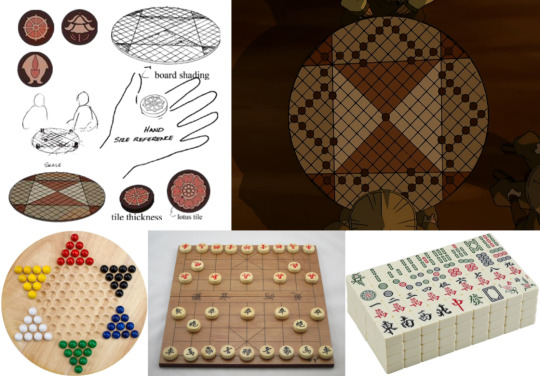
Pai Sho (牌數), meaning "several game pieces" in Chinese, takes inspiration from a few different table games:
Its most obvious influence is the German game Sternhalma, known in the English-speaking world as Chinese Checkers. Like Chinese Checkers, the game is played on a circular board.
The lines on the board and the circular tiles are reminiscent of Xiàngqí (象棋), known in the English-speaking world as Chinese Chess. The pieces often being positioned on the intersection of lines is also very similar to Chinese Chess.
The game's four player limit and visually creative tiles are reminiscent of Mahjong (麻将), China's most famous tile game. In particular, the iconic white lotus tile appears to draw heavily from the classic Mahjong one-dot tile.
Finally, the name Pai Sho was likely inspired by Pai Gow (牌九), meaning "nine game pieces" in Cantonese--- which is both a domino game and a style of poker.
Just like ATLA's animals, it seems that Pai Sho is a fusion of different real life sources. In the next posts, I'll be covering the symbolism and cultural significance behind each Pai Sho tile shown in ATLA.
Like what I’m doing? Tips always appreciated, never expected. ^_^
https://ko-fi.com/atlaculture
#atla#avatar#avatar the last airbender#cultural practices#water tribe#earth kingdom#fire nation#air nomads
523 notes
·
View notes
Text
Avatar headcanon (or AU really since I'm pretty sure it contradicts the lore):
The Air Nomads used to be a lot more violent.
They ate meat too, raising sky bisons and other animals not just for transportation but for food as well. Basically they were more like real nomadic civilizations, except they could fly and (some but not all) were Airbenders.
They waged nomadic warfare as well, raiding settled communities and extorting tributes. And waging war against other tribes of Air Nomads for grazing and raiding territory as well as for revenge of apparent slights. They were extremely loyal to their tribe and kin, above all other loyalties.
Eventually a powerful Air Nomad leader managed to unite the different tribes into one Air nation and he waged a war of conquest across much of the world.
He ruled for many years but after his death his empire was splintered among his descendants and rival warlords. The Air Nomads began to wage war on one another, but this time with a lot more ferocity, with armored Air Bisons and ground armies made up of conquered peoples.
It's during this warring states period that the beginnings of what would become the Air Nomad way developed, as a solution to the never-ending cycle of violence.
The practitioners of the new way adopted pacifism and eventually also vegetarianism. They raised Sky Bison not as property or tools, but as partners and fellow living beings, a sentiment they later expanded to all animals.
The practitioners took in many war orphans as well as babies whose parents couldn't raise them. And when these orphans grew and had kids of their own they often gave them to the temples to be raised there as well. This reinvented the way Air Nomads raised their children, putting harmony and individual growth over ties of blood.
As more and more Air Nomads adopted the new way, eventually the warlords and self-style Air Kings did too. And in time they or their descendants gave up their titles and claims. The now centuries-old way became the way of all Air Nomads.
Though their numbers were smaller, due to their spiritual acuity and their system of mutual aid, the Air Nomad were all much healthier than the other nations and all of them were Airbenders.
#writing#avatar#avatar headcanon#avatar au#atla#avatar the last airbender#air nomads#airbenders#charles writes
456 notes
·
View notes
Text
Do you guys think Zuko made Aang’s final air-nomad outfit?
Like canonically out of them, only Katara and Zuko can sew. And I’d imagine Katara was pretty wrapped up after that final battle with not only healing Sokka’s leg, but knowing her- probably healing anyone else she could get her hands on. And she also would have no knowledge of what traditional air nomad formals would look like.
And yeah I guess Aang could have made it himself. But he was only 12 the last time he saw the monks. And I highly doubt they taught him much past how to repair is own clothing.
But who spent years studying the monks and air bending? Who became obsessed with their culture and traditions in an attempt to find the last one? Who searched all the air temples not once but twice, from top to bottom? Who canonically makes his own clothes (i.e. the blue spirit outfit)?
Zuko, always Zuko
I also like to think that the relic/amulet Aang wears in that same scene was also given to him by Zuko. Just bc I’m sure Zuko kept a lot of air nomad things on his ship, and I think either he or his uncle would have salvaged it- probably out of convenience. Zuko as a reminder of his “purpose”, and Iroh as a symbol of hope.
#avatar the last airbender#atla#zuko#firelord zuko#prince zuko#uncle iroh#Iroh#Katara#sokka#sozins comet#air nomads#Atla lore
586 notes
·
View notes
Text
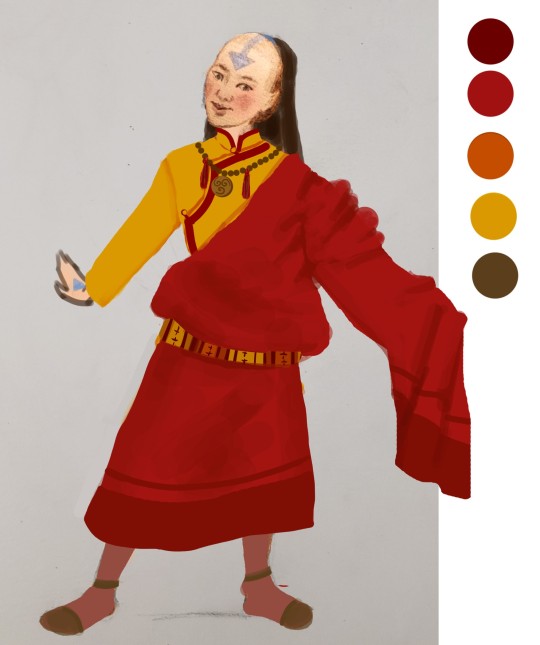
I redesigned Yangchen's outfit!
... I actually designed a lot of outfits for her, because I am Extremely Normal about these books, and also I like costume design and learning about historical clothing.
Short disclaimer: These fantasy clothes aren't culturally or historically accurate, just historically and culturally influenced. I don't have any expertise in East or Central Asian culture or clothing, I've just been clicking around on the internet a lot the last two weeks learning things because that's my idea of fun lol. If you wanted to talk to people who actually know things you should check out @atlaculture or like @ziseviolet, both of whom's blogs I referenced while drawing.
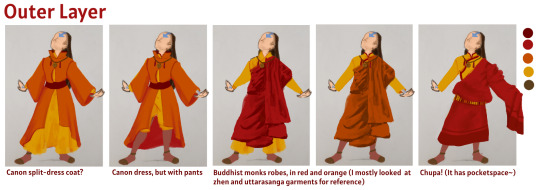
I only designed two alternates for the outer robes. The first is based loosely off the robes Buddhist monks wear (loosely, because drawing draped fabric is hard ^^') especially the Tibetan zhen robe. This garment is just a long wide rectangle of cloth which can be draped across the body in lots of ways (versatility ftw!).
The other garment I drew is a Chuba, a traditional garment from Tibet and the Himalayas. It's a robe, but it highkey reminds me of kilts and hoodies, in that it a) can be worn over one or both shoulders or just as a skirt and b) it makes a giant pocket over the stomach. The long sleeves can be folded up or tied back btw.

I spent the most time on the middle layer, because I was thinking it has to be something she could comfortably fight in while also being suitable for diplomatic meetings, meditating, espionage, and possibly sleeping.
And like. You can fight and hike and whatnot in loose skirts, but it's annoying how twisted up they can get while sleeping. ALSO, YC does a lot of flying and leaping, so my girl needs pants. My faves are definitely the Xiaolin monk pants and the yellow wrap pants Aang wears. I tried dhoti (Indian wrap pants) because that kind of looks like what the giant statue of Yangchen meditating might be wearing, but I think it looks odd paired with a highwaisted shirt instead of a long tunic. Maybe I'll do some more drawings with her in a tunic and dhoti or a monk's dhonka and shemdap later, idk.

As any good historical fashion nerd knows, foundational garments are everything (◡‿◡✿).
But also, there's a scene where Yangchen and Kavik pretend to be lovers, and are "discovered" by a maid sleeping in the same room, with Yangchen in a state of partial undress (gasp!)
I am living for this fake drama; I need to know how scandalized the maid was lmao.
When the maid walks in, Yangchen immediately wraps herself in a bedsheet before ushering the maid back out the door. Maybe all she did was take off her outer robe... but why would she need to wrap herself in a sheet if she was wearing a long-sleeved high-necked gown? I got the sense from both the book and cursory research about buddhist monks that walking around without your outer robes was socially acceptable, at least in casual settings. I think it more likely she was in her underclothes, which historically (in the west anyway) would also double as sleeping clothes.
"The Aang" is censored because this is Tumblr-dot-com. Its mostly a joke, but also, I know other countries are less uptight about bººbies, so like, maybe it's a valid option ¯\_(ツ)_/¯
The ~Water Tribe~ look is based off Sokka's swimwear and not Katara's, mostly because chest binding seems antithetical to airbending.
All the other undergarment designs are based on hanfu neiyi, because that's what I could find reference photos and romanized names for.
I'm tired of typing now. Lemme know if you have questions about something, or want me to post a larger version of a specific outfit. I am open to feedback and tentatively open to requests.
#costume design#character redesign#Yangchen#avatar#airbenders#air nomads#avatar novels#chronicles of the avatar#atla#I realize now there are typos in the jpeg rip#too late to change it now
340 notes
·
View notes
Text

made myself an air nomad oc
from a (at the time of aang) already wiped out group, primarily wearing a blue/yellow color scheme, focused on collecting and preserving the history of smaller tribes in their area
245 notes
·
View notes
Text


A forgotten memory of home
#atla#aang#yangchen#avatar the last airbender#air nomads#air benders#western air temple#atla fanart#украрт
7K notes
·
View notes
Text

Love seeing their happy family
#katara#aang#kataang#avatar the last airbender#art#artist on tumblr#kataangtag#atla#atla fanart#atla fan art#avatar#katara avatar#aang x katara#digital art#air nomads#southern water tribe#bumi ii#bumi atla#bumi lok#bumi tlok#bumi#lok#korra#legend of korra#kataang fanart#kataang family#pro katara#pro aang#my art#leantailean art
234 notes
·
View notes
Text


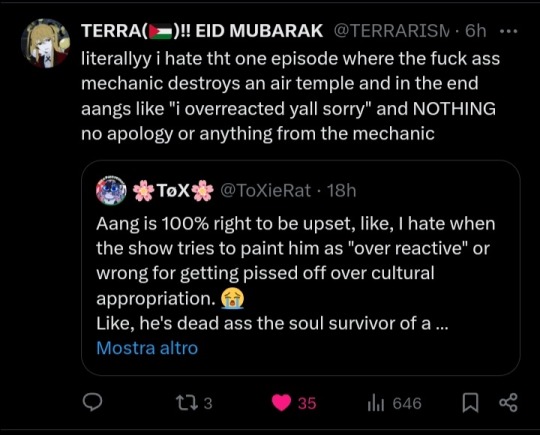

Oh my god i'm glad that atla fandom is finally discussing about this, i hate that episode with a burning passion 😭
And i hate this mf

#avatar the last airbender#atla#aang#katara#sokka#air nomads#genocide#air nomads culture#this is important
124 notes
·
View notes
Text
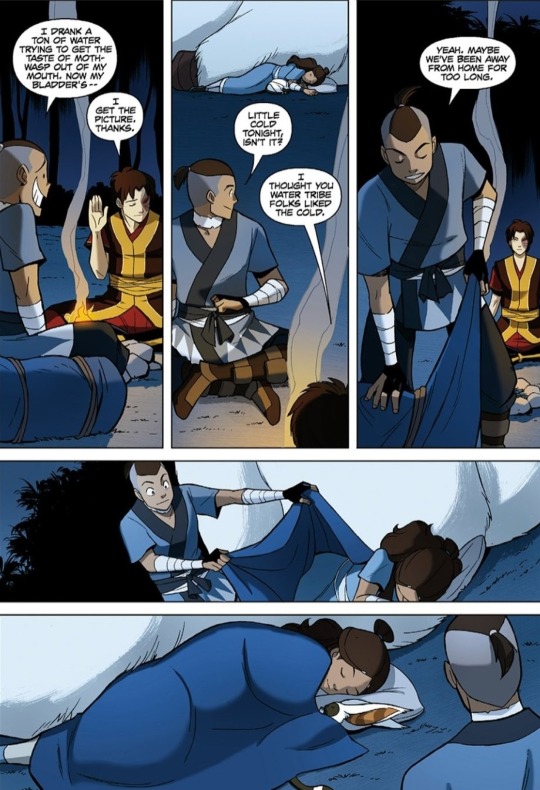
As an only child I'm crying🫡
#avatar the last airbender#atla#atla netflix#natla#aang#katara#sokka#toph#atla suki#zuko#mai atla#ty lee#azula#uncle iroh#kataang#zutara#maiko#water tribe#earth kingdom#fire nation#air nomads#aesthetic#icons#netflix atla
2K notes
·
View notes
Text

Aang and Momo sitting and thinking about home
167 notes
·
View notes
Text
i was rewatching atla as usual and here's something i noticed.
the actual symbols of the 4 elements have their own differences symbolizing how each of the bendings work; water (freedom within the flow of the water), earth (complete control of freedom/discipline), air (full freedom) and fire (freedom within the fire flames)
the swirl, something that each one has, means the freedom of being able to bend, saying that even with their differences they are all connected and are the same.
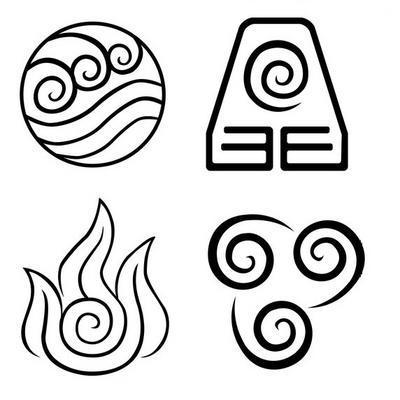
then we see the symbol that the fire nation uses since the war stared (this is just a guess idk if the fire nation used that symbol before the war, but it feels right to say they did not)
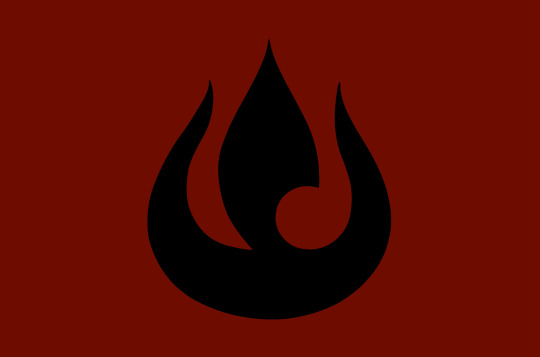

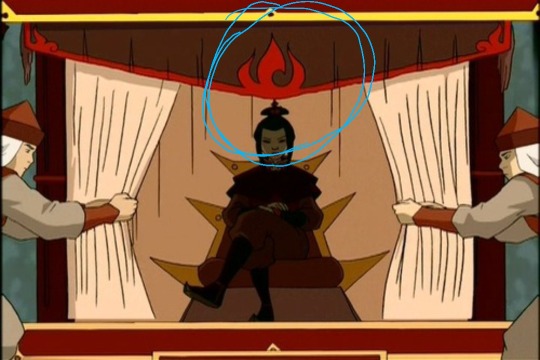
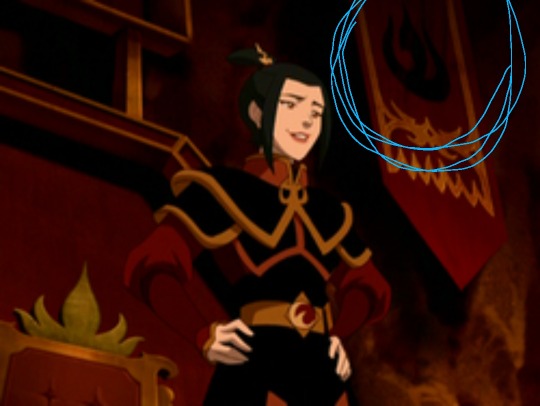
they don't use their element's symbol, they make their own bc they don't want the significance of their actual symbol.
it has no swirl, no freedom and also it differentiates itself from the other nations, not wanting to say that they all are the same. not only that but it's way neater, implying that the fire nation itself is neater or "better" than the rest of the nations.
there's also something really cool I noticed. when iroh teaches zuko fire bending and he's explaining the 4 elements, he uses the "real" fire symbol :)

idk if I'm making this up or if it's canon or if im missing something but i love worlbuilding and trying to find small details
#sorry if this is a mess#english is hard#not really but i dont like writing it#avatar the last airbender#atla#fire nation#air nomads#earth nation#water tribe#aang#zuko#katara#sokka#toph#iroh#worldbuilding
2K notes
·
View notes